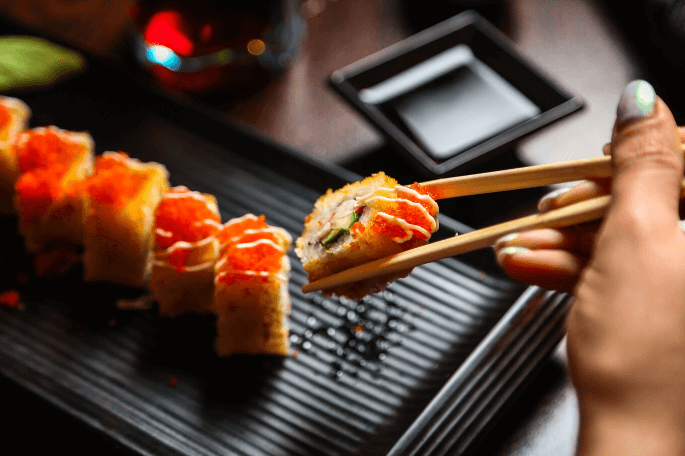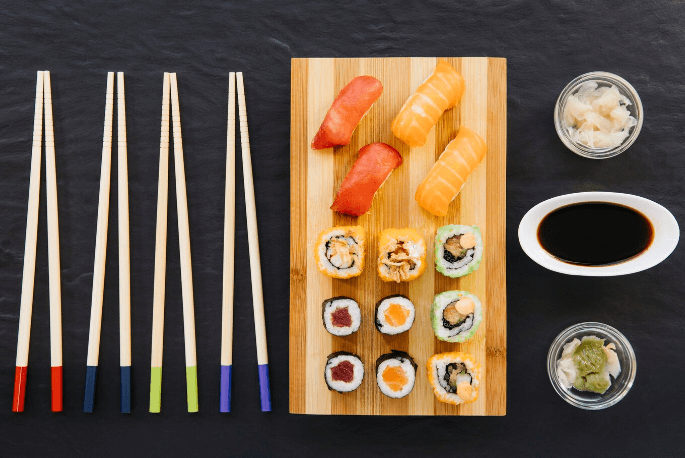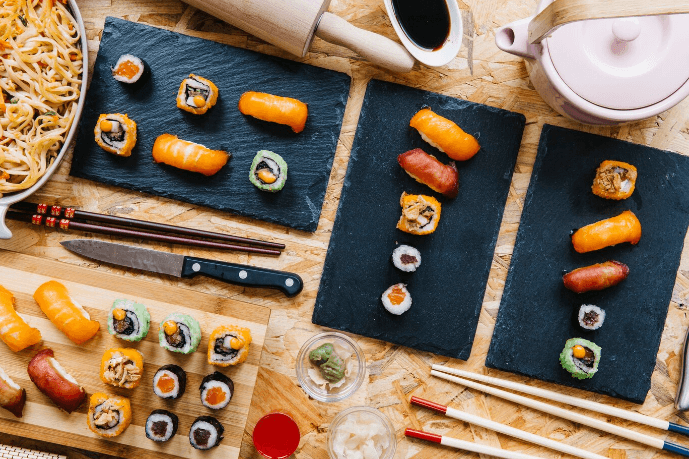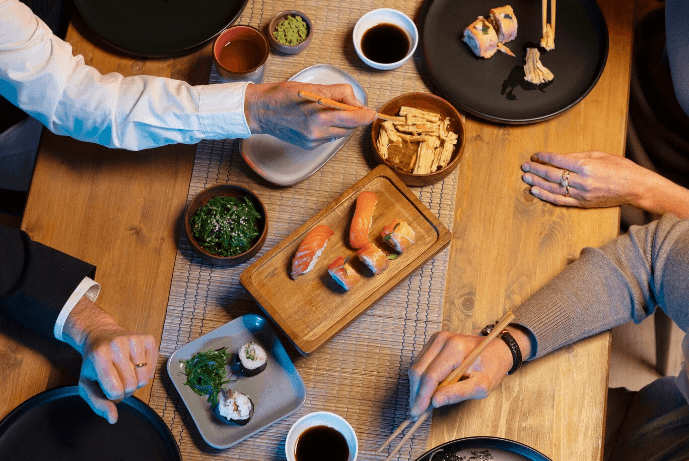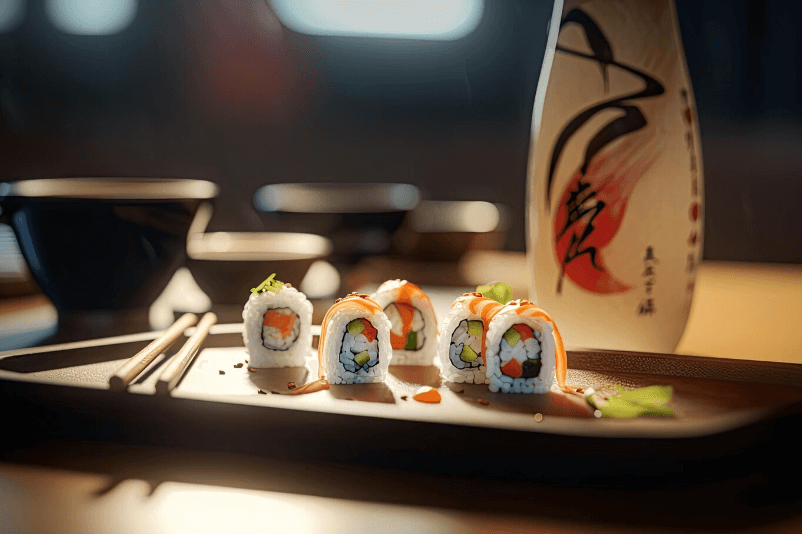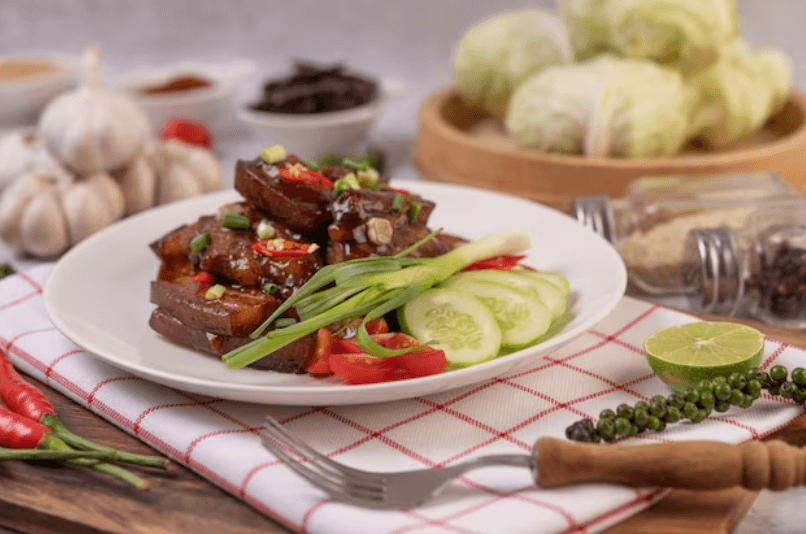Debunking Myths: Common Misconceptions About Sushi
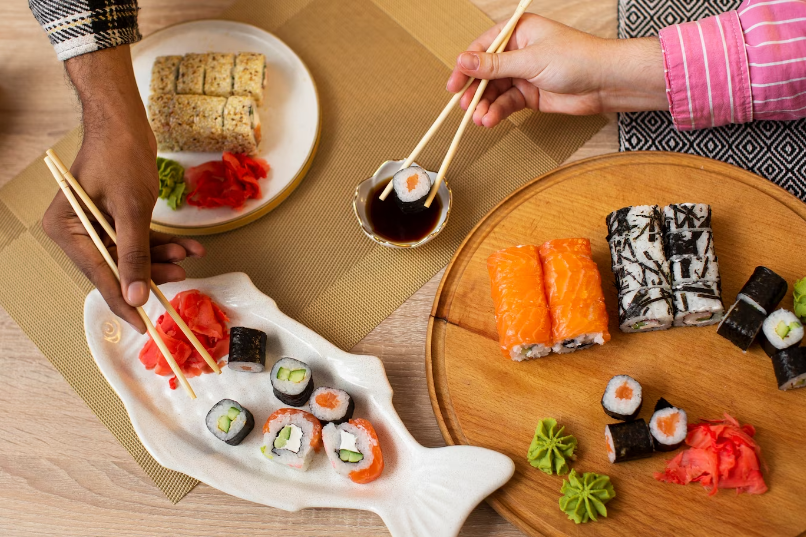
Sushi, a popular Japanese dish, has gained immense popularity around the world. However, there are many common misconceptions about sushi that are widely believed. In this article, we will debunk these myths and reveal the truth about sushi.
One common misconception is that all sushi contains raw fish. While raw fish is commonly used in sushi, there are many other types of sushi that do not include raw fish. Sushi can be made with cooked fish, seafood, or even vegetables. It is the combination of vinegared rice and various ingredients that make sushi, not just raw fish.
Another misconception is that sushi is always expensive. While high-quality sushi can be pricey, there are also affordable options available. Sushi can be enjoyed at different price points, depending on the type of restaurant and the ingredients used. It is important to do some research and explore different sushi establishments to find the best value for money.
“Sushi is not just about raw fish, but rather a harmonious combination of flavors and textures.”
There is also a myth that sushi is only eaten with chopsticks. While chopsticks are commonly used to eat sushi, it is perfectly acceptable to use your hands as well. In fact, certain types of sushi, such as nigiri sushi, are traditionally eaten with the hands. The key is to enjoy sushi in a way that is comfortable for you.
By debunking these common misconceptions, we hope to shed light on the truth about sushi. It is a versatile and delicious cuisine that offers something for everyone, whether you prefer raw fish or not. So next time you indulge in sushi, remember that there is more to it than meets the eye!
Sushi: Beyond Raw Fish
When most people think of sushi, they automatically imagine raw fish. However, this common misconception is just one of many myths about sushi that need to be debunked. Sushi is so much more than just raw fish, and it’s important to understand the variety and depth of this beloved Japanese cuisine.
One of the biggest myths about sushi is that it is always served raw. While raw fish, or sashimi, is a popular type of sushi, there are actually many other types that don’t involve raw fish at all. For example, nigiri sushi consists of a small mound of rice with a slice of cooked or raw fish on top. Maki sushi, or sushi rolls, can also be made with a variety of cooked ingredients such as tempura shrimp, grilled eel, or even vegetables.
Another common misconception is that sushi always contains seafood. While seafood is a staple ingredient in many sushi dishes, there are also plenty of vegetarian options available. Inari sushi, for instance, is made with sushi rice wrapped in a pocket of seasoned, sweet tofu. Vegetable rolls, like cucumber or avocado rolls, are also popular choices for those who prefer to avoid seafood.
Furthermore, sushi is not limited to just fish and rice. Many sushi chefs get creative with their ingredients, incorporating different flavors and textures to create unique and delicious rolls. Some examples include the California roll, which typically contains cucumber, avocado, and crabstick, and the Philadelphia roll, which features smoked salmon, cream cheese, and cucumber.
So, the next time you think of sushi, remember that it goes beyond raw fish. Sushi is a versatile cuisine that offers something for everyone, whether you’re a seafood lover or a vegetarian. Don’t let the myths and misconceptions about sushi stop you from exploring the wide range of flavors and combinations that this Japanese delicacy has to offer.
Sushi and Health: A Surprising Truth
When it comes to sushi, there are many misconceptions surrounding its health benefits. In this article, we aim to debunk some of the common myths surrounding sushi and shed light on the surprising truth.
One of the most common misconceptions about sushi is that it is always healthy. While sushi can be a nutritious choice, not all sushi rolls are created equal. In fact, some sushi rolls can be high in calories, sodium, and unhealthy fats. It’s important to choose sushi options that are made with fresh, high-quality ingredients and opt for healthier fillings such as vegetables or lean proteins like salmon or tuna.
Another myth surrounding sushi is that it is always raw. While raw fish is a popular choice for sushi, there are also many cooked options available. Cooked sushi rolls can be just as delicious and offer a variety of flavors and textures. If you’re not a fan of raw fish or are concerned about the potential risks, there are plenty of cooked sushi options to choose from.
Some people also mistakenly believe that all sushi is gluten-free. While sushi rice itself does not contain gluten, some sushi rolls may use sauces, marinades, or fillings that contain gluten. It’s important to ask your sushi chef or read the menu carefully if you have a gluten sensitivity or allergy.
Lastly, there is a misconception that sushi is always expensive. While some high-end sushi restaurants can be pricey, there are also many affordable sushi options available. Sushi can be found in grocery stores, food courts, and even fast-casual restaurants at a range of price points to fit different budgets.
In conclusion, sushi can be a healthy and delicious choice, but it’s important to separate fact from fiction. By debunking the common myths surrounding sushi, we can make informed choices about our sushi selections and enjoy this traditional Japanese cuisine with confidence.
Sushi: More than a Trendy Dish
When it comes to sushi, there are many common myths and misconceptions. Debunking these misconceptions is essential to understanding the true nature of this Japanese delicacy.
One of the most common myths about sushi is that it is always raw fish. While raw fish, or sashimi, is a popular form of sushi, it is not the only option. Sushi can also be made with cooked fish, seafood, or even vegetables. It is the combination of vinegared rice and various ingredients that make up the diverse world of sushi. This myth often discourages people from trying sushi, as they may not be fans of raw fish. However, with the wide range of options available, there is something for everyone to enjoy.
Another myth surrounding sushi is that it is only for the wealthy or high-end foodies. While sushi was traditionally considered a luxury food in Japan, it has become much more accessible and affordable in recent years. You can find sushi in various price ranges, from budget-friendly options at local sushi bars to high-end omakase experiences. Sushi has become a global phenomenon, enjoyed by people of all backgrounds and income levels.
Furthermore, there is a misconception that sushi is difficult to make at home. While it does require some skill and practice, making sushi at home can be a fun and rewarding experience. With the right ingredients and tools, anyone can create their own sushi rolls or nigiri. There are plenty of online tutorials and resources available to help beginners get started. Making sushi at home can also be a great way to experiment with different flavors and ingredients.
In conclusion, sushi is more than just a trendy dish. By debunking common myths and misconceptions, we can appreciate the true diversity and accessibility of sushi. Whether you prefer raw or cooked ingredients, dining out or making it at home, sushi offers something for everyone to enjoy.
The Origins of Sushi
There are many common misconceptions and myths about the origins of sushi. Contrary to popular belief, sushi did not originate in Japan, but actually has its roots in Southeast Asia. The word “sushi” refers to the vinegared rice used in sushi dishes, rather than the raw fish often associated with the cuisine.
The earliest form of sushi can be traced back to ancient China, where a preservation technique known as narezushi was used. This involved fermenting fish with rice, which helped to extend the shelf life of the fish. This method eventually made its way to Japan around the 8th century AD, where it was further developed and refined.
Initially, sushi was consumed as a quick snack or street food by the Japanese. It wasn’t until the Edo period in the 19th century that sushi began to be served as a formal dining experience. During this time, the technique of using raw fish as a topping for sushi rice became popular.
Today, sushi has evolved into a wide variety of flavors and styles, both in Japan and around the world. From traditional nigiri sushi to modern rolls, there is a sushi dish to suit every palate. However, it’s important to separate the myths from the facts and understand the true origins of this beloved cuisine.
So, the next time you enjoy a delicious sushi roll, remember that it has a rich history that goes beyond the common misconceptions about its origins.
Sushi Rice: More Than Just White Rice
When it comes to sushi, there are many misconceptions and myths that are often associated with this delicious Japanese dish. One of the most common misconceptions is that sushi rice is just plain white rice. However, this couldn’t be further from the truth.
Sushi rice is a crucial element of sushi, and it is far from being just plain white rice. In fact, sushi rice is a specially seasoned rice that is prepared with a specific vinegar mixture. This unique mixture gives sushi rice its distinct flavor and sticky texture that is essential in making sushi.
The seasoning process involves adding a combination of rice vinegar, sugar, and salt to the cooked rice while it is still hot. This mixture is then gently mixed into the rice, allowing the flavors to blend together and infuse the grains. This process not only gives sushi rice its delicious taste but also helps in preserving the rice and inhibiting bacterial growth.
Another important aspect of sushi rice is the type of rice used. Sushi rice is typically made from short-grain rice, which has a higher starch content compared to long-grain rice. This higher starch content helps in creating the sticky texture that is perfect for shaping sushi rolls and nigiri.
| Myth | Fact |
| Sushi rice is just plain white rice. | Sushi rice is specially seasoned with a vinegar mixture. |
| Sushi rice is made from any type of rice. | Sushi rice is typically made from short-grain rice. |
| Sushi rice is tasteless. | Sushi rice has a distinct flavor due to the vinegar seasoning. |
So the next time you enjoy sushi, remember that the rice used is much more than just plain white rice. It is a carefully seasoned rice that adds a unique flavor and texture to this beloved Japanese dish.
Sushi: A Balanced and Nutritious Meal
In the world of myths and misconceptions about sushi, one of the most common ones is that it is not a balanced or nutritious meal. However, this couldn’t be further from the truth.
Sushi is not just a delicious treat; it is also a well-rounded and healthy option. Made primarily from fresh fish, rice, and vegetables, sushi combines protein, carbohydrates, and essential nutrients in a single dish.
Rich in omega-3 fatty acids, sushi is an excellent source of healthy fats that promote heart health and reduce inflammation. The raw fish used in sushi also provides high-quality protein, amino acids, and important minerals like iodine and zinc.
Additionally, sushi is typically served with pickled ginger and wasabi, which are both known for their antibacterial properties and can aid digestion. Soy sauce, another common accompaniment, can provide a boost of sodium and flavor, but should be enjoyed in moderation.
Moreover, sushi is often prepared with seaweed, which is packed with vitamins and minerals, including calcium, iron, and iodine. It is also an excellent source of dietary fiber, aiding in digestion and promoting a healthy gut.
While some may worry about the raw fish in sushi, it is important to note that sushi made with fresh and high-quality ingredients is generally safe to consume. In fact, sushi chefs undergo extensive training to ensure proper handling and preparation techniques to minimize the risk of foodborne illnesses.
In conclusion, sushi is not just a cultural delicacy; it is a balanced and nutritious meal. By debunking common myths and misconceptions, we can appreciate sushi for the healthy and delicious option it truly is.
Sushi: Traditional versus Western
When it comes to sushi, there are many common misconceptions and myths surrounding this beloved Japanese dish. One prevalent misconception is that all sushi is raw fish. However, this is not true. While some types of sushi do feature raw fish, there are also numerous options that incorporate cooked ingredients such as shrimp, eel, or even vegetables.
Another myth about sushi is that it is always served with wasabi. While wasabi is a common condiment for sushi, it is not always included. In traditional sushi, the chef typically applies a small amount of wasabi directly onto the sushi before serving it. However, in Western-style sushi, wasabi is often served on the side, allowing diners to add it according to their preference.
The misconception that sushi is only made with rice and fish is also widespread. In truth, there are numerous variations of sushi that do not include fish at all. For example, vegetarian sushi options often feature ingredients like avocado, cucumber, or pickled vegetables. Additionally, sushi can also be made with other types of protein, such as tofu or even cooked meat.
Traditional sushi is typically served in small, bite-sized pieces known as nigiri or maki rolls. These rolls consist of a small amount of fish or other ingredients wrapped in seaweed and rice. On the other hand, Western-style sushi often features larger rolls, sometimes known as California rolls, that are filled with various ingredients and then wrapped in seaweed and rice.
It is important to debunk these common myths and misconceptions about sushi to embrace the diversity and versatility of this delicious Japanese dish. Whether you prefer traditional sushi or enjoy exploring the creative options of Western-style sushi, there is something for everyone to enjoy.
Myth Truth
| All sushi is raw fish | There are many types of sushi that feature cooked ingredients or no fish at all. |
| Sushi always contains wasabi | Wasabi is a common condiment for sushi but is not included in every type of sushi. |
| Sushi is only made with rice and fish | Sushi can be made with a variety of ingredients, including vegetables, tofu, or cooked meat. |
| Traditional sushi is always served as bite-sized nigiri or maki rolls | Western-style sushi often features larger rolls, such as California rolls. |
The Art of Sushi Making
Sushi is not just a food, it is an art. There are many myths and misconceptions about sushi that often lead to misunderstandings. By debunking these common misconceptions, we can gain a better understanding of the true art of sushi making.
Sushi Etiquette: Do’s and Don’ts
When it comes to enjoying sushi, there are certain etiquette rules that every sushi lover should know. Let’s debunk some common myths and misconceptions about sushi etiquette.
Myth #1: It’s okay to use chopsticks to eat sushi.
Contrary to popular belief, sushi is traditionally eaten with the hands. The use of chopsticks is generally reserved for sashimi, which is raw fish without the rice.
Myth #2: Wasabi should be mixed into soy sauce.
This is a big no-no. In Japan, the wasabi is already added to the sushi by the chef, and dipping the sushi into soy sauce should be done with a light touch to avoid overpowering the delicate flavors of the fish.
Myth #3: Sushi should always be eaten in one bite.
While it’s ideal to eat nigiri, which is a slice of fish on top of a small mound of rice, in one bite, it’s not mandatory. Feel free to take smaller bites if you prefer, just be sure to finish each piece before moving on to the next.
Myth #4: Ginger should be eaten with the sushi.
Contrary to popular belief, pickled ginger is meant to be eaten in between different types of sushi to cleanse the palate. It should not be eaten with the sushi itself, as it can interfere with the flavors.
Myth #5: Sushi should always be dipped in soy sauce.
It is customary to dip sushi into soy sauce fish-side down, not rice-side down. This not only prevents the rice from falling apart but also allows the fish to absorb the soy sauce without overpowering it. Additionally, it’s important to be mindful of how much soy sauce is used, as excessive dipping can be viewed as disrespectful to the chef’s careful balance of flavors.
Myth #6: You should eat sushi rolls with your hands.
Sushi rolls, also known as maki, can be eaten with your hands or with chopsticks, depending on personal preference. However, if using chopsticks, be cautious not to squeeze the roll, as it can cause the contents to spill out.
Myth #7: It’s rude to ask for substitutions or changes.
While it’s best to respect the chef’s creativity and expertise, it is perfectly acceptable to request adjustments if you have dietary restrictions or allergies. However, it’s important to do so politely and with consideration for the chef’s expertise.
By understanding and following sushi etiquette, you can fully appreciate the art and flavors of this beloved Japanese cuisine.
Sushi Rolls: Beyond California Roll
When it comes to sushi, one of the most common misconceptions is that the California roll is representative of all sushi rolls. However, this could not be further from the truth. While the California roll may be popular in Western countries, it is just one of many types of sushi rolls available.
There is a wide variety of sushi rolls beyond the California roll, each with its own unique flavors and ingredients. For example, the spicy tuna roll is a favorite among sushi lovers. It consists of a roll filled with spicy tuna and topped with slices of avocado. The spicy kick of the tuna combined with the creamy texture of the avocado makes for a truly delicious combination.
Another popular sushi roll is the Rainbow roll. This roll is made with a variety of fish such as tuna, salmon, and yellowtail, along with avocado and cucumber. The different colors of the fish give the roll its name and create a visually appealing dish.
One misconception about sushi rolls is that they always contain raw fish. While many rolls do contain raw fish, there are also plenty of options for those who prefer cooked seafood or vegetarian ingredients. Rolls like the shrimp tempura roll or the vegetable roll are perfect for those looking for a non-raw fish option.
It is important to remember that sushi is a versatile cuisine with a wide range of rolls to suit all tastes and dietary preferences. So the next time you think about sushi, don’t limit yourself to just the California roll. Explore the world of sushi rolls and discover the many delicious options waiting for you.
Sashimi: The Art of Eating Raw Fish
When it comes to sushi, one of the most commonly misunderstood terms is sashimi. Sashimi is often confused with sushi, but in fact, they are two distinct dishes. Sashimi is a Japanese delicacy that consists of thinly sliced raw fish or seafood that is served without rice. It is typically enjoyed with soy sauce, wasabi, and pickled ginger.
One of the common misconceptions about sashimi is that it is unsafe to eat raw fish. However, when prepared properly, sashimi is perfectly safe to consume. The fish used in sashimi is carefully chosen for its freshness and quality, and it is served at a temperature that ensures any potentially harmful bacteria are destroyed.
Another myth about sashimi is that it is only made with fish. While fish is the most common ingredient used in sashimi, it can also be made with other types of seafood, such as shrimp, scallops, or octopus. The key is to use the freshest ingredients, as the subtle flavors of the raw seafood are the star of the dish.
Contrary to popular belief, sashimi does not always have to be served raw. In some cases, the fish or seafood may be lightly seared or marinated before being sliced and served as sashimi. This variation adds depth of flavor to the dish while still allowing the natural flavors of the seafood to shine through.
Sashimi is not just about the taste, it is also about the presentation. The art of slicing the fish or seafood into delicate, thin slices requires skill and precision. The slices are often arranged in a visually appealing manner, creating a feast for the eyes as well as the palate.
So, the next time you have the opportunity to try sashimi, don’t let the common myths and misconceptions deter you. Embrace the art of eating raw fish and discover the fresh, delicate flavors that this Japanese delicacy has to offer.
Nigiri: The Simplicity of Raw Fish and Rice
When it comes to sushi, there are many misconceptions that need to be debunked. One of these misconceptions is that sushi refers only to raw fish. In reality, sushi is a combination of vinegared rice and various ingredients, which may or may not include raw fish. Nigiri, a common type of sushi, showcases the simplicity of raw fish and rice.
Nigiri is made by placing a small amount of raw fish, such as tuna or salmon, on top of a small mound of vinegared rice. It is often served with a dab of wasabi and a thin strip of seaweed called nori to hold everything together. This simple combination allows the flavors of the fish and the rice to shine through.
Contrary to popular belief, nigiri does not require the use of raw fish. It can also be made with cooked ingredients, such as shrimp or eel. The key is to use high-quality fish or seafood that is fresh and has a natural sweetness.
The simplicity of nigiri allows the diner to fully appreciate the quality and flavors of the raw fish. The delicate texture and subtle taste of the fish, combined with the slightly tangy and slightly sweet rice, create a harmonious balance that is both satisfying and delicious.
Next time you enjoy sushi, remember that nigiri is more than just raw fish. It is a testament to the art of sushi making, showcasing the simplicity and beauty of combining raw fish and rice in a way that allows the ingredients to shine.
Sushi and Sustainability: Debunking the Myth
When it comes to sushi, there are many misconceptions and myths surrounding its sustainability. Let’s take a closer look at some of the common beliefs and debunk them to separate fact from fiction.
This is not true. While it is true that some fish species are overfished or caught using unsustainable methods, not all sushi is made with endangered fish. Many sushi restaurants and suppliers are committed to serving sustainable seafood and are careful about avoiding species that are threatened or at risk.
While it is true that irresponsible and unsustainable fishing practices can contribute to overfishing and depletion of marine resources, not all sushi consumption has the same impact. Sushi made with sustainably sourced fish and seafood can actually have a lower environmental impact compared to other types of meat consumption.
While it is true that sushi preparation can require a certain amount of energy, it is important to consider the bigger picture. Sushi can be prepared using energy-efficient methods, and many sushi restaurants are making efforts to reduce their energy consumption and adopt sustainable practices.
While rice cultivation can have environmental impacts, such as water usage and pesticide contamination, sushi rice is not the main culprit. The environmental impact of rice production depends on the farming practices used. Sushi restaurants and suppliers can source rice from sustainable farms that employ responsible farming methods.
- Myth #1: Sushi is always made with endangered fish species.
- Myth #2: Sushi contributes to overfishing and depletion of marine resources.
- Myth #3: Sushi is not environmentally friendly due to the high energy consumption in its preparation.
- Myth #4: Sushi rice is harmful to the environment due to water usage and pesticide contamination.
It is important to remember that not all sushi is created equal in terms of sustainability. By supporting sushi restaurants and suppliers that prioritize sustainability and responsible sourcing, we can enjoy this delicious cuisine while minimizing our impact on the environment.
The Truth About Sushi Allergies
When it comes to sushi, there are many common myths and misconceptions surrounding allergies. It’s important to debunk these false beliefs in order to better understand the truth about sushi allergies.
One common myth is that all sushi contains raw fish, which can be a major allergen for some individuals. While it’s true that many traditional types of sushi do include raw fish, there are also plenty of options available that use cooked or vegetarian ingredients. This means that sushi can still be enjoyed by individuals with fish allergies, as long as they choose the right types of sushi.
Another misconception is that all sushi is gluten-free. While rice, the main ingredient in sushi, is gluten-free, other components such as soy sauce and imitation crab meat can contain gluten. It’s important for individuals with gluten allergies to be cautious and communicate their dietary restrictions with the sushi chef when ordering.
Some people believe that sushi is automatically safe for individuals with shellfish allergies, as they assume that shellfish is only used in certain types of sushi. However, shellfish can be a hidden ingredient in many sushi dishes, including various types of sauces and even the rice vinegar used to season the sushi rice. It’s crucial for individuals with shellfish allergies to inform the sushi chef about their allergy to avoid any potential cross-contamination.
In conclusion, sushi allergies are complex and can vary from person to person. While sushi can be a delicious and enjoyable dining option for many individuals, it’s important to be knowledgeable about the potential allergens present in sushi and communicate any allergies or dietary restrictions to the sushi chef. By doing so, you can safely enjoy the experience of eating sushi while avoiding any allergic reactions.
Q&A:
Is sushi always raw fish?
No, it’s a common misconception that sushi is always raw fish. Sushi refers to the vinegared rice that is used as the base for various toppings, which can include raw or cooked fish, vegetables, or even tofu.
Why is sushi so expensive?
There are several factors that contribute to the high cost of sushi. First, the quality of the ingredients used is crucial, especially when it comes to the fish. Fresh, high-quality fish is more expensive. Second, making sushi requires a high level of skill and precision, which adds to the labor costs. Additionally, the overhead costs of running a sushi restaurant, such as rent and utilities, also play a role in the final price.
Is it safe to eat raw fish in sushi?
Yes, raw fish in sushi is generally safe to eat as long as it has been properly handled and prepared. Sushi chefs are trained to select fresh, high-quality fish and take necessary precautions to avoid contamination. It’s important to choose a reputable sushi restaurant that follows proper hygiene and food safety practices.
Can vegetarians eat sushi?
Yes, vegetarians can enjoy sushi. There are many vegetarian sushi options available, such as cucumber rolls, avocado rolls, or vegetable rolls. Some sushi restaurants even offer creative vegetarian rolls with ingredients like tofu, sweet potato, or mushroom. However, it’s always a good idea to inform the sushi chef about your dietary preferences to ensure that there are no hidden non-vegetarian ingredients in the sushi.
